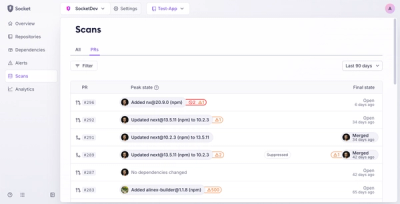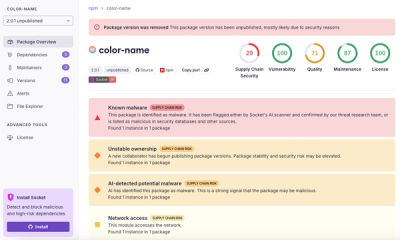
Security News
MCP Steering Committee Launches Official MCP Registry in Preview
The MCP Steering Committee has launched the official MCP Registry in preview, a central hub for discovering and publishing MCP servers.
dotenv file generator from schema and user input.
Do you copy and rewrite the .env file when you prepare the environment for your project? Enput generates an .env file by answering a minimum of questions.
Enput runs on Node.js. Installation is not required.
First prepare an .env.example file; Enput will generate an .env file from it.
Then type the following command.
npx enput
All that remains is to enter the environment variables according to what appears on the console screen.
Congratulations👏 An .env file has been generated.
If .env.example is updated in the future and new environment variables are added, type the same command again. Add the missing environment variables to the .env file.
Add a comment in front of each environment variable in the .env.example file. The number of # is not important, although ## is used here to improve readability.
##
# Node execution environment
# @type select
# @options local,development,staging,production
##
NODE_ENV=production
@type followed by the type of the environment variable. In this case, NODE_ENV will be the item from which to choose.
All types are here.
stringsecretemailurldatedatetimeipnumberintbooleanselectlistAll tags are here.
| Tag | |
|---|---|
@type | Type of the environment variable. Default is string. |
@copy | Skip user input and copy the default value verbatim. |
@min | Minimum value (minimum number of characters for strings). |
@max | Maximum value (maximum number of characters for strings). |
@length | Fixed number of characters in the value |
@pattern | Regular expression pattern for the value |
@multiple | Allows multiple selections when of type select. |
@options | Options for type select. |
It can also be installed.
npm install -g enput
See help for command usage.
> enput -h
Usage: enput [options] [vars...]
Generate or update a .env file from .env.example and user input.
Arguments:
vars filtering and setting environment variables
Examples:
filter enput NODE_ENV PORT
set value enput NODE_ENV=production
set empty value enput NODE_ENV=
set value with space enput MESSAGE='Hello world'
Options:
-v, --version output the version number
-m, --mode <mode> if given, adds a suffix to the .env filename
-e, --env <envFile> .env file name (default: ".env")
-s, --schema <schemaFile> schema file name (default: ".env.example")
-f, --force disable verification
-u, --update check each schema for updates
-q, --quiet hide information
-h, --help display help for command
FAQs
dotenv file generator from schema and user input
We found that enput demonstrated a not healthy version release cadence and project activity because the last version was released a year ago. It has 1 open source maintainer collaborating on the project.
Did you know?

Socket for GitHub automatically highlights issues in each pull request and monitors the health of all your open source dependencies. Discover the contents of your packages and block harmful activity before you install or update your dependencies.

Security News
The MCP Steering Committee has launched the official MCP Registry in preview, a central hub for discovering and publishing MCP servers.

Product
Socket’s new Pull Request Stories give security teams clear visibility into dependency risks and outcomes across scanned pull requests.

Research
/Security News
npm author Qix’s account was compromised, with malicious versions of popular packages like chalk-template, color-convert, and strip-ansi published.